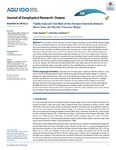Tidally Induced Overflow of the Faroese Channels Bottom Water Over the Wyville Thomson Ridge
| dc.contributor.author | Vlasenko, Vasyl | |
| dc.contributor.author | Stashchuk, Nataliya | |
| dc.date.accessioned | 2018-10-13T13:12:53Z | |
| dc.date.available | 2018-10-13T13:12:53Z | |
| dc.date.issued | 2018-09 | |
| dc.identifier.issn | 2169-9275 | |
| dc.identifier.issn | 2169-9291 | |
| dc.identifier.uri | http://hdl.handle.net/10026.1/12500 | |
| dc.description.abstract |
©2018. The Authors. An overflow of dense cold water from the Faroese Channels across the Wyville Thomson Ridge (WTR) into the Rockall Trough was recorded during the 136th cruise of the RRS James Cook in June 2016. This event happened in the eastern part of the ridge. The remotely operated vehicle ISIS deployed for a collection of coral samples recorded an abrupt drop in temperature at 500-m depth. Specifically, the water temperature decreased from 8.73 to 6.74 °C and salinity from 35.26 to 35.16. This rapid drop happened over 20 min, with the fastest rate of water temperature decrease of 1.10 °C occurring just over 1 min 50 s. The numerical modeling conducted to reproduce the event has shown that a massive overflow took place in the WTR section, which is close to the Darwin Mounds. The overflow has led to resuspension of bottom sediments; the remotely operated vehicle sampling program in the area of the Darwin Mounds terminated due to low visibility. The numerical experiments have shown that tidally induced overflows over the WTR can occur periodically under spring tidal conditions. The model allowed us to identify two places in the eastern part of the WTR where the tidally driven overflows more realistically can happen. | |
| dc.format.extent | 6753-6765 | |
| dc.language | en | |
| dc.language.iso | en | |
| dc.publisher | American Geophysical Union | |
| dc.subject | Faroese Channels | |
| dc.subject | bottom water | |
| dc.subject | oveflow | |
| dc.subject | Wyville Thomson Ridge | |
| dc.subject | internal tide | |
| dc.title | Tidally Induced Overflow of the Faroese Channels Bottom Water Over the Wyville Thomson Ridge | |
| dc.type | journal-article | |
| dc.type | Journal Article | |
| plymouth.author-url | https://www.webofscience.com/api/gateway?GWVersion=2&SrcApp=PARTNER_APP&SrcAuth=LinksAMR&KeyUT=WOS:000447552600042&DestLinkType=FullRecord&DestApp=ALL_WOS&UsrCustomerID=11bb513d99f797142bcfeffcc58ea008 | |
| plymouth.issue | 9 | |
| plymouth.volume | 123 | |
| plymouth.publication-status | Published | |
| plymouth.journal | Journal of Geophysical Research: Oceans | |
| dc.identifier.doi | 10.1029/2018JC014365 | |
| plymouth.organisational-group | /Plymouth | |
| plymouth.organisational-group | /Plymouth/Faculty of Science and Engineering | |
| plymouth.organisational-group | /Plymouth/Faculty of Science and Engineering/School of Biological and Marine Sciences | |
| plymouth.organisational-group | /Plymouth/REF 2021 Researchers by UoA | |
| plymouth.organisational-group | /Plymouth/REF 2021 Researchers by UoA/UoA07 Earth Systems and Environmental Sciences | |
| plymouth.organisational-group | /Plymouth/Research Groups | |
| plymouth.organisational-group | /Plymouth/Research Groups/Marine Institute | |
| plymouth.organisational-group | /Plymouth/Users by role | |
| plymouth.organisational-group | /Plymouth/Users by role/Academics | |
| dcterms.dateAccepted | 2018-09-04 | |
| dc.rights.embargodate | 2019-1-11 | |
| dc.identifier.eissn | 2169-9291 | |
| dc.rights.embargoperiod | Not known | |
| rioxxterms.versionofrecord | 10.1029/2018JC014365 | |
| rioxxterms.licenseref.uri | http://www.rioxx.net/licenses/all-rights-reserved | |
| rioxxterms.type | Journal Article/Review | |
| plymouth.funder | Influence of population connectivity on depth-dependent diversity of deep-sea marine benthic biota::NERC |


